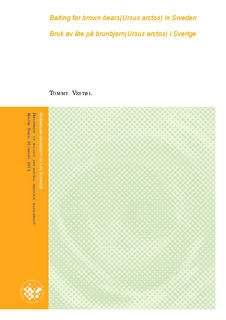| dc.description.abstract | Summary
Hunting for brown bear (Ursus arctos) has a long tradition in Scandinavia, from the times
when the populations of bears were far above the level that we have today, and for a century
when the policy was to eradicate all predators in Scandinavia. However with successful
management, the brown bear population grew from about 130 individuals to about 3,300
today. Quota hunting in Sweden began in 1943. Hunting with bait was an important hunting
method before it was banned in 2001. Now interest groups want this method to be allowed
again Sweden. Authorities want a better scientific basis for deciding the question of initiation
of hunting with bait. The need for a scientific study that deals with hunting with bait and how
bears use of bait site is great since there is little scientific knowledge on this topic.
To find out how bears use bait sites, I have used a remote camera to record the use of various
bait sites types and in two areas of Sweden. Two of the main questions were whether the
bears actually use the bait and time of day they visit bait site. Sweden has set a limit on when
hunting starts and ends each day; one hour after sunrise and two hours before sunset
respectively. The results of this study show that bears visiting bait sites, mostly in the
morning before sunrise and after sunset in the evening. I have also examined whether there is
any difference between the numbers of visits on bait sites that are permanent, i.e. actively
baiting from the bears emerge from the den in the spring until denning in October or
November, and temporary bait sites started a few weeks before the bear hunting period. The
results show that permanent bait sites had the most visits throughout the season, whereas
temporary bait sites had more visits in the hunting season, compared with permanent bait sites
in the same period. Generally, hunting with bait could help to decrease the number of
wounded bears and the necessity to search for wounded bears. Hunting with bait may also
contribute to determining the age-and sex of harvested bears in those cases where the hunter
has a better ability to determine age and sex, compared with a dog hunting. The conclusion of
this study is that hunting with bait will not result in more harvested bears, because few bears
visit the bait in the time window for legal hunting during the day, especially with the short
daylight during the legal hunting season for bears. | no_NO |
